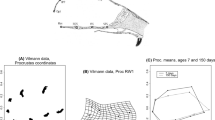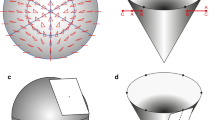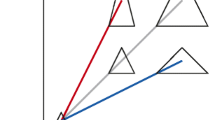Abstract
In 1932, Julian Huxley introduced biologists around the world to a simple method for fitting two-parameter power equations, \( Y\, = \,b \times \, X^{k} \), to bivariate observations that follow a curvilinear path on the arithmetic (= linear) scale. The method entails fitting a straight line to logarithmic transformations of the data and then (at least implicitly) back-transforming the resulting equation to the arithmetic domain. This general approach continues to be in wide use by students of biological allometry despite its several limitations and shortcomings. For example, Huxley’s allometric method requires that the bivariate data of interest follow the path of a straight line in log domain (i.e., that the data be loglinear). However, many datasets that are otherwise suitable for allometric analysis do not meet the requirement for loglinearity and consequently are beyond the scope of Huxley’s method. Such data can usually be examined in the untransformed state by nonlinear regression, and the regression approach enables investigators to fit models with different functional form and random error. Moreover, by combining nonlinear regression with a categorical variable, investigators can compare sets of observations that follow curvilinear paths on the arithmetic scale. The regression protocol is illustrated by re-examining data for relative growth by the internal hinge ligament in a bivalve mollusk and by the elongated snout in garfish (Actinopterygii). The methodology promoted by Huxley has played a major role in development of the field of biological allometry, but the procedure has been superseded by nonlinear regression.


Similar content being viewed by others
References
Anderson DR (2008) Model based inference in the life sciences: a primer on evidence. Springer, New York
Anderson DR, Burnham KP, Gould WR, Cherry S (2001) Concerns about finding effects that are actually spurious. Wildl Soc Bull 29:311–316
Bainbridge JR (1969) Miscalculation? Bioscience 19:770. https://doi.org/10.2307/129478
Ballantyne F IV (2013) Evaluating model fit to determine if logarithmic transformations are necessary in allometry: a comment on the exchange between Packard (2009) and Kerkhoff and Enquist (2009). J Theor Biol 317:418–421. https://doi.org/10.1016/j.jtbi.2012.09.035
Burnham KP, Anderson DR (2002) Model selection and multimodel inference, 2nd edn. Springer, New York
Burnham KP, Anderson DR, Huyvaert KP (2011) AIC model selection and multimodel inference in behavioral ecology: some background, observations, and comparisons. Behav Ecol Sociobiol 65:23–35. https://doi.org/10.1007/s00265-010-1029-6
Chatfield C (1995) Model uncertainty, data mining and statistical inference [with discussion]. J Roy Stat Soc A 158:419–466. https://doi.org/10.2307/2983440
Churchill FB (1993) On the road to the k constant: a historical introduction. In: Problems of relative growth, new edn. Johns Hopkins University Press, Baltimore, pp xix–xlv
Espe SE (1936) Relative growth in the fresh water ganoids. Master of Science Thesis, Univ Illinois, Urbana, USA
Felsenstein J (1985) Phylogenies and the comparative method. Am Nat 125:1–15. https://doi.org/10.1086/284325
Finney DJ (1989) Was this in your statistics textbook? VI. Regression and covariance. Exp Agric 25:291–311
Fuentes-G JA, Housworth EA, Weber A, Martins EP (2016) Phylogenetic ANCOVA: estimating changes in evolutionary rates as well as relationships between traits. Am Nat 188:615–627. https://doi.org/10.1086/688917
Gayon J (2000) History of the concept of allometry. Am Zool 40:748–758. https://doi.org/10.1668/0003-1569(2000)040%5B0748:HOTCOA%5D2.0.CO;2
Glass N (1969) Discussion of calculation of power function with special reference to respiratory metabolism in fish. J Fish Res Bd Can 26:2643–2650. https://doi.org/10.1139/f69-256
Glazier DS (2013) Log-transformation is useful for examining proportional relationships in allometric scaling. J Theor Biol 334:200–203. https://doi.org/10.1016/j.jtbi.2013.06.017
Glazier DS (2014) Metabolic scaling in complex living systems. Systems 2:451–540. https://doi.org/10.3390/systems2040451
Gould SJ (1966) Allometry and size in ontogeny and phylogeny. Biol Rev 41:587–640. https://doi.org/10.1111/j.1469-185X.1966.tb01624.x
Gould SJ (1975) Allometry in primates, with emphasis on scaling and the evolution of the brain. Contrib Primatol 5:244–292
Grafen A (1989) The phylogenetic regression. Philos Trans R Soc Lond B 326:119–157. https://doi.org/10.1098/rstb.1989.0106
Gray J (1929) The kinetics of growth. Br J Exp Biol 6:248–274
Hafley WL (1969) Calculation and miscalculation of the allometric equation reconsidered. Bioscience 19:974–983. https://doi.org/10.2307/1294972
Hand DJ (1998) Data mining: statistics and more? Am Statist 52:112–118. https://doi.org/10.2307/2685468
Hand DJ, Blunt G, Kelly MG, Adams MN (2000) Data mining for fun and profit. Stat Sci 15:111–126. https://doi.org/10.1214/ss/1009212753
Harvey PH (1982) On rethinking allometry. J Theor Biol 95:37–41. https://doi.org/10.1016/0022-5193(82)90285-5
Huxley JS (1924) Constant differential growth-ratios and their significance. Nature 114:895–896. https://doi.org/10.1038/114895a0
Huxley JS (1932) Problems of relative growth. Methuen, London. (https://archive.org/details/problemsofrelati033234mbp/page/n10). Accessed 23 Oct 2019
Huxley JS (1950) Relative growth and form transformation. Proc R Soc B 137:465–469. https://doi.org/10.1098/rspb.1950.0055
Kammerer CF, Grande L, Westneat MW (2006) Comparative and developmental functional morphology of the jaws of living and fossil gars (Actinopterygii: Lepisosteidae). J Morphol 267:1017–1031. https://doi.org/10.1002/jmor.10293
Kerkhoff AJ, Enquist BJ (2009) Multiplicative by nature: why logarithmic transformation is necessary in allometry. J Theor Biol 257:519–521. https://doi.org/10.1016/j.jtbi.2008.12.026
Lasiewski RC (1969) Prefers logarithmic plotting. Bioscience 19:673. https://doi.org/10.2307/1294889
Lasiewski RC, Dawson WR (1969) Calculation and miscalculation of the equations relating avian standard metabolism to body weight. Condor 71:335–336. https://doi.org/10.2307/1366309
Lolli L, Batterham AM, Kratochvíl L, Flegr J, Weston KL, Atkinson G (2017) A comprehensive allometric analysis of 2nd digit length to 4th digit length in humans. Proc R Soc B 284:20170356. https://doi.org/10.1098/rspb.2017.0356
Lumer H (1937) The consequences of sigmoid growth for relative growth functions. Growth 1:140–154
Manaster BJ, Manaster S (1975) Techniques for estimating allometric equations. J Morphol 147:299–308. https://doi.org/10.1002/jmor.1051470305
Medawar PB (1950) Transformation of shape. Proc R Soc B 137:474–479. https://doi.org/10.1098/rspb.1950.0057
Mitzenmacher M (2004) A brief history of generative models for power law and lognormal distributions. Internet Math 1:226–251. https://doi.org/10.1080/15427951.2004.10129088
Niklas KJ, Hammond ST (2019) On the interpretation of the normalization constant in the scaling equation. Front Ecol Evol 6:212. https://doi.org/10.3389/fevo.2018.00212
Packard GC (2012a) Is non-loglinear allometry a statistical artifact? Biol J Linn Soc 107:764–773. https://doi.org/10.1111/j.1095-8312.2012.01995.x
Packard GC (2012b) Julian Huxley, Uca pugnax, and the allometric method. J Exp Biol 215:569–573. https://doi.org/10.1242/jeb.061739
Packard GC (2015) Quantifying the curvilinear metabolic scaling in mammals. J Exp Zool A 323:540–546. https://doi.org/10.1002/jez.1946
Packard GC (2016) Relative growth by the elongated jaws of gars: a perspective on polyphasic loglinear allometry. J Exp Zool B 326:168–175. https://doi.org/10.1002/jez.b.22673
Packard GC (2017a) Is complex allometry in field metabolic rates of mammals a statistical artifact? Comp Biochem Physiol A 203:322–327. https://doi.org/10.1016/j.cbpa.2016.10.005
Packard GC (2017b) Misconceptions about logarithmic transformation and the traditional allometric method. Zoology 123:115–120. https://doi.org/10.1016/j.zool.2017.07.005
Packard GC (2017c) Why allometric variation in mammalian metabolism is curvilinear on the logarithmic scale. J Exp Zool A 327:537–541. https://doi.org/10.1002/jez.2129
Packard GC (2018a) A new research paradigm for bivariate allometry: combining ANOVA and nonlinear regression. J Exp Biol. https://doi.org/10.1242/jeb.177519
Packard GC (2018b) Evolutionary allometry of horn length in the mammalian family Bovidae reconciled by non-linear regression. Biol J Linn Soc 125:657–663. https://doi.org/10.1093/biolinnean/bly052
Packard GC (2019) The fallacy of biphasic growth allometry for the vertebrate brain. Biol J Linn Soc. https://doi.org/10.1093/biolinnean/blz075
Pantin CFA (1932) Form and size. Nature 129:775–777. https://doi.org/10.1038/129775a0
Pasternack BS, Gianutsos RR (1969) Application of the exponential and power functions to the study of allometric growth, with particular reference to doryline ants. Am Nat 103:225–234. https://doi.org/10.1086/282597
Reeve ECR (1940) Relative growth in the snout of anteaters. A study in the application of quantitative methods to systematics. Proc Zool Soc Lond A 110:47–80
Reeve ECR, Huxley JS (1945) Some problems in the study of allometric growth. In: Le Gros Clark WE, Medawar PB (eds) Essays on growth and form presented to D’Arcy Wentworth Thompson. Oxford University Press, Oxford, pp 121–156
Ritz C, Streibig JC (2008) Nonlinear regression with R. Springer, New York
Sartori AF, Ball AD (2009) Morphology and postlarval development of the ligament of Thracia phaseolina (Bivalvia: Thraciidae), with a discussion of model choice in allometric studies. J Mollusc Stud 75:295–304. https://doi.org/10.1093/mollus/eyp029
Shea BT (1985) Bivariate and multivariate growth allometry: statistical and biological considerations. J Zool A 206:367–390. https://doi.org/10.1111/j.1469-7998.1985.tb05665.x
Sholl D (1948) The quantitative investigation of the vertebrate brain and the applicability of allometric formulae to its study. Proc R Soc B 135:243–258. https://doi.org/10.1098/rspb.1948.0009
Sholl DA (1950) The theory of differential growth analysis. Proc R Soc B 137:470–474. https://doi.org/10.1098/rspb.1950.0056
Smaers JB, Rohlf FJ (2016) Testing species’ deviation from allometric predictions using the phylogenetic regression. Evolution 70:1145–1149. https://doi.org/10.1111/evo.12910
Smith RJ (1980) Rethinking allometry. J Theor Biol 87:97–111. https://doi.org/10.1016/0022-5193(80)90222-2
Smith RJ (1984) Allometric scaling in comparative biology: problems of concept and method. Am J Physiol 246:R152–R160. https://doi.org/10.1152/ajpregu.1984.246.2.R152
Sprent P (1972) The mathematics of size and shape. Biometrics 28:23–37. https://doi.org/10.2307/2528959
Strauss RE (1993) The study of allometry since Huxley. In: Problems of relative growth, new edn. Johns Hopkins University Press, Baltimore, pp xlvii–lxxv
Stumpf MPH, Porter MA (2012) Critical truths about power laws. Science 335:665–666. https://doi.org/10.1126/science.1216142
Thompson DW (1942) On growth and form. A new edition. Macmillan, New York
Verwijst T (1991) Logarithmic transformations in biomass estimation procedures: violation of the linearity assumption in regression analysis. Biomass Bioenerg 1:175–180. https://doi.org/10.1016/0961-9534(91)90026-9
Warton DI, Wright IJ, Falster DS, Westoby M (2006) Bivariate line-fitting methods for allometry. Biol Rev 81:259–291. https://doi.org/10.1017/S1464793106007007
Warton DI, Duursma RA, Falster DS, Taskinen S (2012) SMATR 3 – an R package for estimation and inference about allometric lines. Meth Ecol Evol 3:257–259. https://doi.org/10.1111/j.2041-210X.2011.00153.x
White CR, Kearney MR (2014) Metabolic scaling in animals: methods, empirical results, and theoretical explanations. Compr. Physiol 4:231–256. https://doi.org/10.1002/cphy.c110049
White EP, Xiao X, Isaac NJB, Sibly RM (2012) Methodological tools. In: Sibly RM, Brown JH, Kodric-Brown A (eds) Metabolic ecology: A scaling approach. Wiley, Hoboken, pp 9–20
Xiao X, White EP, Hooten MB, Durham S (2011) On the use of log-transformation vs. nonlinear regression for analyzing biological power laws. Ecology 92:1887–1894. https://doi.org/10.1890/11-0538.1
Yates F (1950) The place of statistics in the study of growth and form. Proc R Soc B 137:479–488. https://doi.org/10.1098/rspb.1950.0058
Zar JH (1968) Calculation and miscalculation of the allometric equation as a model in biological data. Bioscience 18:1118–1120. https://doi.org/10.2307/1294589
Acknowledgements
I thank Andrea Cardini and an anonymous referee for their support of my work and for helpful suggestions for revising the original manuscript.
Funding
This investigation was funded by the author out-of-pocket and did not receive financial support from any agency in the public, commercial, or not-for-profit sectors.
Author information
Authors and Affiliations
Contributions
The investigation was conceived by the author, and he performed all the statistical analyses and prepared the manuscript.
Corresponding author
Ethics declarations
Conflict of interest
The author declares that he has no conflict of interest.
Human and animal rights
This article is based on data that were reported previously in the literature and consequently did not require the taking of new measurements on either humans or animals.
Additional information
Publisher's Note
Springer Nature remains neutral with regard to jurisdictional claims in published maps and institutional affiliations.
Electronic supplementary material
Below is the link to the electronic supplementary material.
Rights and permissions
About this article
Cite this article
Packard, G.C. Julian Huxley and the quantification of relative growth. Zoomorphology 139, 131–140 (2020). https://doi.org/10.1007/s00435-019-00466-0
Received:
Revised:
Accepted:
Published:
Issue Date:
DOI: https://doi.org/10.1007/s00435-019-00466-0




